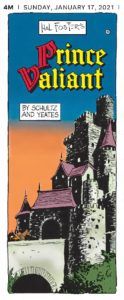How Comics and Cartoons Work in Newspapers
Skip to commentsA couple newspaper editors broke down the processes of how comic strips and editorial cartoons appear in your local gazette.
First up is The Oregonian explaining their Sunday Comics section.
Why would The Oregonian cut the first two panels from the Feb. 14, 2021, “Doonesbury” comic? Is this a regular editorial practice?
This is indeed regular editorial practice and has been for decades. The syndicate, which provides comic strips to us, offers them in various shapes and formats.
We use a vendor to create the pages of comics we have chosen for our readers. Other papers have different mixes of comic strips and may have only one, two or four pages of comics. Needless to say, putting together the Sunday comics for thousands of newspapers nationwide is a weekly puzzle.
That’s why the syndicates provide page designers as much flexibility as possible. The strip we published Sunday originally had eight panels. The first two were left out by the page designers.
Except, as everyone knows, a full Sunday Doonesbury has nine panels. The February 14 title panel:
© G. B. Trudeau
Which gets me on a soapbox rant…
That Doonesbury title panel is not readily available unless you can find a place that carries it and bookmark that site. Neither Doonesbury.com nor GoComics carries that title panel. Why I don’t know.
Some may remember that I applaud King Features for making the Prince Valiant title panel only available to newspaper readers. But that strikes me as different. The PV title panel is a large art showcase, while the Doonesbury title panel is a constant, though with a small story-related illustration.
 The current Prince Valiant title panel.
The current Prince Valiant title panel.
© King Features Syndicate
© GEC Inc.
Now try to find the Sunday Luann title panel.
Back to how newspapers and cartoons work together.
As the Red Rock News explains:
There are several departments at a newspaper: Editorial aka news, Advertising, Classifieds, Circulation, Production, Subscriptions, Legal and Billing.
The Editorial Department and Advertising Departments of newspapers are separate. Editorial doesn’t tell advertising reps who to sell ads to and the Advertising Department doesn’t tell news reporters who to cover nor in what way to cover an advertising client.
Well, ideally. Also ideally:
The news stories written by our reporters are unbiased by design and practice. Journalists report the events as they occur, quote the figures involved, read and research documents and do their best to inform our readers about what’s going on in the community. They contact both or all sides of a issue to present readers with a clear picture. The stories they write are and should be devoid of a political stance or angle.
As for editorial cartoons…
Rob Pudim has been a professional cartoonist since 1964 and our cartoonist since Sept. 20, 1989. He reads our newspapers and draws cartoons based solely on his impression as a reader. He doesn’t ask for any guidance and we never tell him what to draw.
© Rob Pudim
And that’s how newspapers and comics come together for your enjoyment.
More or less.



Comments 1
Comments are closed.